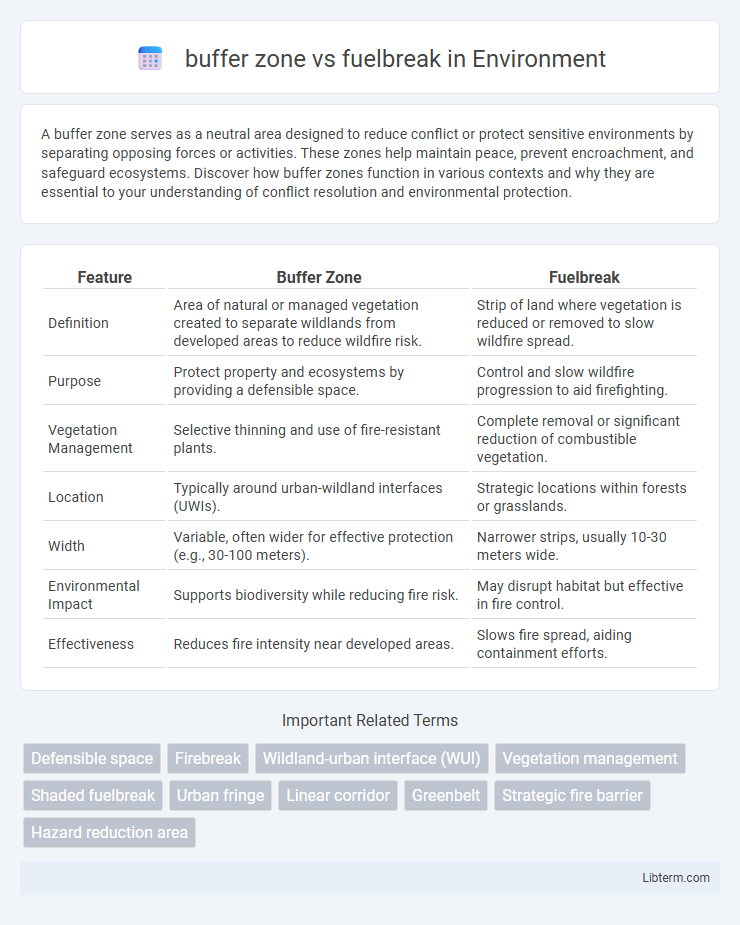A buffer zone serves as a neutral area designed to reduce conflict or protect sensitive environments by separating opposing forces or activities. These zones help maintain peace, prevent encroachment, and safeguard ecosystems. Discover how buffer zones function in various contexts and why they are essential to your understanding of conflict resolution and environmental protection.
Table of Comparison
| Feature | Buffer Zone | Fuelbreak |
|---|---|---|
| Definition | Area of natural or managed vegetation created to separate wildlands from developed areas to reduce wildfire risk. | Strip of land where vegetation is reduced or removed to slow wildfire spread. |
| Purpose | Protect property and ecosystems by providing a defensible space. | Control and slow wildfire progression to aid firefighting. |
| Vegetation Management | Selective thinning and use of fire-resistant plants. | Complete removal or significant reduction of combustible vegetation. |
| Location | Typically around urban-wildland interfaces (UWIs). | Strategic locations within forests or grasslands. |
| Width | Variable, often wider for effective protection (e.g., 30-100 meters). | Narrower strips, usually 10-30 meters wide. |
| Environmental Impact | Supports biodiversity while reducing fire risk. | May disrupt habitat but effective in fire control. |
| Effectiveness | Reduces fire intensity near developed areas. | Slows fire spread, aiding containment efforts. |
Introduction to Buffer Zones and Fuelbreaks
Buffer zones and fuelbreaks are critical fire management tools designed to reduce wildfire risk and control fire spread. Buffer zones serve as protective areas surrounding communities or natural resources where vegetation is managed to minimize fire intensity, while fuelbreaks are strategically cleared strips that interrupt fuel continuity, aiding in fire containment. Implementing these zones enhances landscape resilience by creating defensible spaces and slowing wildfire progression.
Defining Buffer Zones
Buffer zones are designated areas established around fire-prone landscapes to reduce the risk of wildfire spread by creating a barrier of low-flammability vegetation or cleared land. Unlike fuelbreaks, which are narrow strips specifically designed to interrupt or slow fire progression, buffer zones encompass broader regions that serve as protective buffers for communities, infrastructure, or natural resources. Defining buffer zones involves strategic placement based on topography, vegetation type, and prevailing wind patterns to maximize their effectiveness in wildfire mitigation.
Understanding Fuelbreaks
Fuelbreaks are strategically designed clearings that reduce available vegetation to slow or stop wildfire spread, creating defensible spaces primarily along fire-prone perimeters. Unlike buffer zones, which serve as multipurpose barriers for environmental protection and resource management, fuelbreaks specifically target fire behavior modification by interrupting fuel continuity and reducing fire intensity. Properly implemented fuelbreaks integrate fire-resistant vegetation and regularly maintained open areas to enhance wildfire control and protect critical infrastructure.
Key Differences Between Buffer Zones and Fuelbreaks
Buffer zones and fuelbreaks serve distinct roles in wildfire management; buffer zones create a defensible space by clearing vegetation around structures to reduce fire intensity, while fuelbreaks are strategically placed strips of reduced fuels designed to slow or stop wildfire spread across larger landscapes. Buffer zones primarily protect individual properties and communities by minimizing heat exposure and ember intrusion, whereas fuelbreaks function as tactical fire control lines used by firefighters to manage and redirect wildfires. The key difference lies in their scale and purpose: buffer zones focus on localized fire prevention near assets, while fuelbreaks operate on broader terrain to influence wildfire behavior.
Objectives and Functions of Buffer Zones
Buffer zones serve as protective barriers around sensitive ecosystems, aiming to reduce human impact and pollution while preserving biodiversity. Their primary function is to mitigate environmental disturbances by filtering runoff, controlling access, and maintaining ecological balance. Unlike fuelbreaks, which focus on reducing wildfire threats by removing flammable vegetation, buffer zones emphasize ecological conservation and landscape stability.
Primary Purposes of Fuelbreaks
Fuelbreaks primarily serve to reduce the intensity and spread of wildfires by removing or altering vegetation that fuels fire behavior. Unlike buffer zones, which generally create a physical separation between properties or land uses, fuelbreaks strategically modify the landscape to slow fire progression and provide safer access for firefighting efforts. These managed strips of land enhance fire control effectiveness and protect critical infrastructure, ecosystems, and human communities from wildfire damage.
Implementation Strategies for Buffer Zones
Implementing buffer zones requires strategic land use planning that integrates native vegetation barriers to reduce wildfire spread effectively. Techniques involve selective thinning, controlled burns, and creating discontinuous fuel patterns to enhance resilience in forested areas. Monitoring vegetation regrowth and coordinating with local fire management agencies ensure the buffer zone maintains its protective function over time.
Design and Maintenance of Fuelbreaks
Fuelbreaks are strategically designed linear clearings that remove or reduce combustible vegetation to slow wildfire spread and facilitate fire suppression, with specific dimensions tailored to local vegetation, topography, and fire behavior. Their maintenance involves regular removal of flammable materials, pruning, and mowing to ensure effectiveness, contrasting with broader, less intensively managed buffer zones designed primarily for ecological separation. Effective fuelbreak design integrates durable access routes and considers soil stability to minimize erosion, ensuring long-term operational viability in wildfire management.
Effectiveness in Wildfire Prevention
Buffer zones create a broader area of reduced fuels and vegetation, enhancing the effectiveness of wildfire prevention by slowing fire spread and providing safer conditions for firefighting efforts. Fuelbreaks target specific strips or lines where vegetation is thinned or removed to act as barriers, effectively slowing fire progress but offering less overall protection compared to buffer zones. Studies show buffer zones contribute to more significant fire intensity reduction and control, while fuelbreaks are strategic tools within larger wildfire management plans.
Choosing Between Buffer Zones and Fuelbreaks
Choosing between buffer zones and fuelbreaks depends on specific wildfire risk, vegetation type, and property layout. Buffer zones consist of multiple vegetation layers reduced in density to slow fire spread, ideal for protecting residential areas adjacent to forests. Fuelbreaks are strategically cleared strips designed to halt or redirect wildfires, making them effective for large-scale fire control along access routes or property boundaries.
buffer zone Infographic

 libterm.com
libterm.com